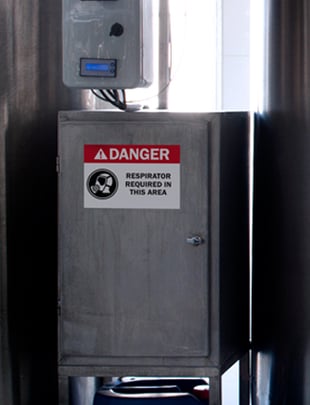HazCom Plans Crucial in Preventing Employee Exposure

Employees conducting degreasing work in an enclosed space were found by OSHA to have been irresponsibly exposed to hazardous chemical vapors. The report shows the employer failed to determine a need for and supply respirators and ventilation, did not develop a respiratory protection program, had a lack in personal protective equipment, and did not ensure proper use of compressed air for cleaning purposes. The machining company in Pennsylvania faces penalties totaling at least $14,700.
Chemical Dangers
Inhaling petroleum, chlorine, or alcohol based solvents used to dissolve machining fluids and other contaminants is dangerous. Not only is there fire danger with certain chemicals, but without proper ventilation or a lack of protective gear such as respirators or gloves, workers may be exposed to fumes or burns from hazardous chemicals. This can result in respiratory illnesses or even death. Vapor degreasing involves using solvents in vapor form to cleanse materials in preparation for further finishing operations, such as painting, bonding, or welding.
"Employers must monitor their facilities to ensure workplace health and safety procedures are adequate and effective," said Jean Kulp, OSHA Area Office Director in Allentown. "Exposure to these types of hazardous chemical vapors can lead to serious illnesses and health issues."
Communicating chemical hazards in a workplace is important to workers as well as those who come to assist during an emergency. Workplace chemicals caused a deadly explosion and fire in New York recently. While workers were injured during an exposure incident, firefighters were also injured from a reaction blast. This has drawn attention from New York Senator Chuck Schumer on the need for better communication of chemical safety information to local first responders, fire departments, and others. OSHA currently does not automatically send notifications, to those who may be first on the scene, of workplace incidents but were open to the thought of creating a notification system.
 Streamline Chemical Communication
Streamline Chemical Communication
Safety managers can keep chemical hazard communication up to date using Safety Data Sheets and comply with OSHA's HazCom 2012 regulations. Conduct hazard determinations on chemicals with which employees will be working with to assure the accuracy and completeness of information provided by suppliers. Establish an effective hazard communication program by determining hazards through OSHA's four steps:
- Make a list of chemicals to evaluate
- Collect data
- Analyze the collected data
- Document the hazard determination process and the results obtained
Workers can prevent catastrophic events around dangerous chemicals through education, proper PPE, and signage that alerts workers to nearby chemical hazards. Help ensure employees understand the hazards posed by the chemicals with which they work with by providing clear instructions and reminders, including handling and storage guidelines, firefighting measures, exposure controls, and more in the free HazCom 2012 Labeling Best Practice Guide
Related Resources

Hazardous Chemicals Overview
In the eyes of OSHA, hazardous materials run the gamut from household cleaners to deadly gasses. Effects can ...
Read
HazCom Basics: Chemical Labeling 101
In the regulatory-driven healthcare environment, proper chemical labeling is required to ensure safety and ...
Read
Avert Chemical Safety Program Failures
Facilities that handle chemicals need to be aware of the potential hazards of each chemical. Part of ...
Read.png)




